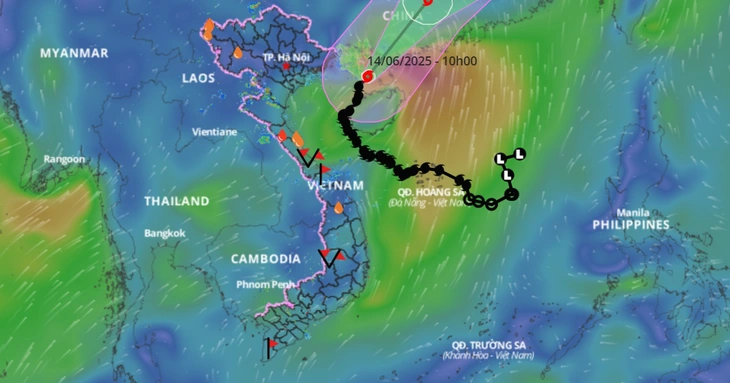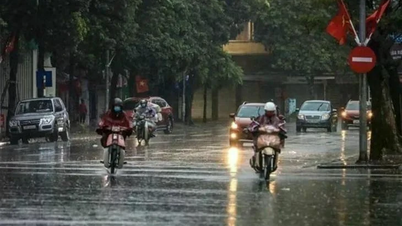
Path of storm No. 1 - Photo: VIETNAM DISASTER MONITORING SYSTEM
Talking to Tuoi Tre Online about the storm rules, Mr. Le Dinh Quyet - Head of the Forecasting Department of the Southern and Central Highlands Hydrometeorological Station - stated that each storm has a different trajectory. However, statistics from many years show that there are storms with similar trajectories.
The trajectory of a storm depends on many factors including external and internal forces within the storm.
External factors include cold air, low pressure troughs, and tropical convergence zones. In particular, storms depend heavily on the activity of the West Pacific high pressure (subtropical high pressure).
This high pressure exists at an altitude of 3,000 - 5,000m. We can imagine this high pressure as a mass of high pressure air in the center, gradually decreasing towards the edge. The wind blows from the center, when the edge of the high pressure moves westward, creating isobars that curve in an arc or nearly a semi-ellipse, its peak is high in the west.
In many cases, the subtropical high pressure acts as a guiding current for the storm. Therefore, tropical depressions and storms will follow the edge of this Western Pacific high pressure to move.
According to statistics, over 90% of tropical cyclones (storms, tropical depressions) in the Pacific Ocean form from the tropical convergence zone.
The tropical convergence zone is usually formed by the northeast monsoon and the southwest monsoon. Therefore, this form often has an axis that is almost east-west, or northwest-northwest, east-southeast. This axis is relatively perpendicular to our country.
When a tropical depression or storm forms right on the tropical convergence zone, it will gradually slide westward. Normally, the air pressure on land will be lower than on the sea, so the storm or tropical depression will move westward, west-northwest.
The moving trajectory is then not only affected by external forces but also by internal forces such as temperature in the storm circulation, humidity, and forces generated within the storm itself.
Regarding storm No. 1, in addition to the above analysis factors, it is also affected by the subtropical high pressure encroaching on the west. The storm follows the edge, so its initial trajectory is northwest. Later, it gradually bends and heads towards Hainan Island, then gradually heads out as it is now and tends to enter Leizhou as forecast.
"The trajectory of this storm No. 1 is nothing special. It is consistent with the impact of weather systems, suitable for operating during the storm and flood season," said Mr. Quyet.
Source: https://tuoitre.vn/bao-so-1-co-bat-thuong-khong-20250614145630144.htm


























![[Photo] The 9th Congress of the Party Committee of the Office of the President, term 2025-2030](https://vphoto.vietnam.vn/thumb/1200x675/vietnam/resource/IMAGE/2025/6/20/78e7f27e8c4b4edc8859f09572409ad3)

























![[Maritime News] Wan Hai Lines invests $150 million to buy 48,000 containers](https://vphoto.vietnam.vn/thumb/402x226/vietnam/resource/IMAGE/2025/6/20/c945a62aff624b4bb5c25e67e9bcc1cb)












































Comment (0)